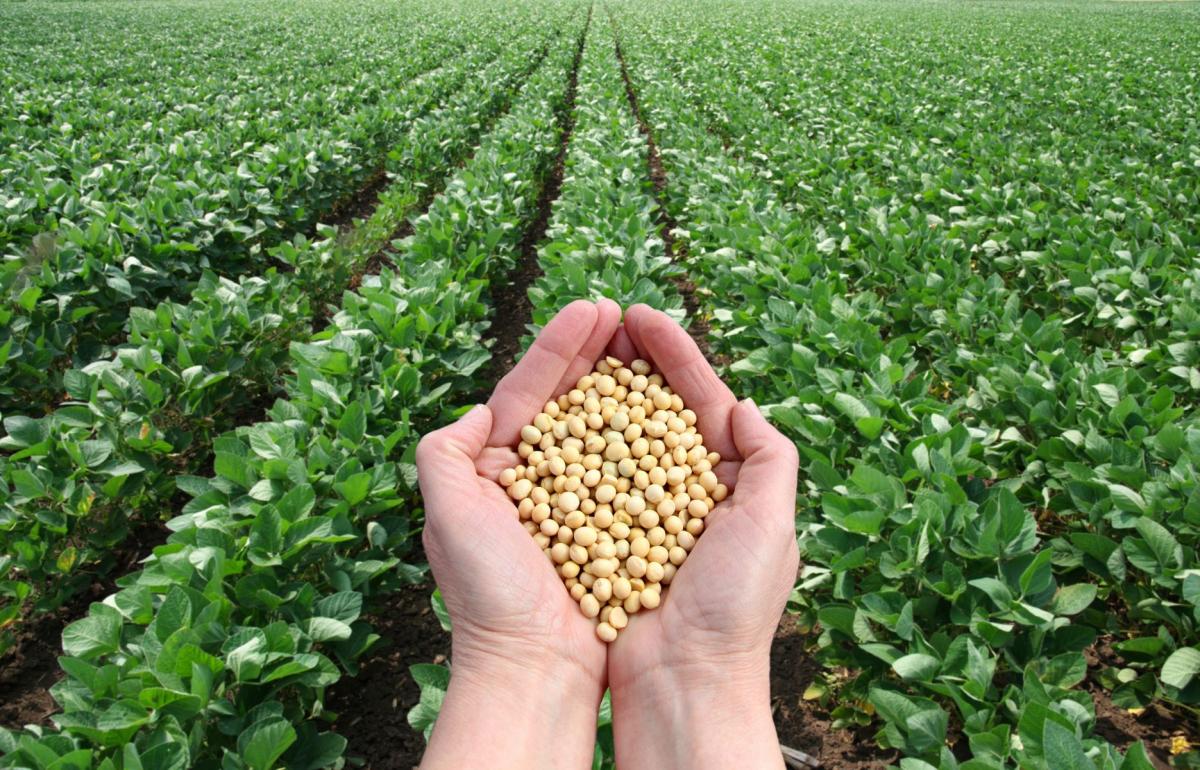Nutrient Deficiencies
Throughout the growing season, soybeans may show signs of chlorosis or discoloring of their leaves. There are many different factors that can lead to the discoloration of soybean leaves, such as unfavorable weather conditions, insects, disease, herbicide injury or an interaction of different factors. Nutrient deficiencies can be a reason for chloroctic symptoms and is something to consider when determining the cause for the discoloration. Each nutrient generally has its own unique symptoms when the nutrient is limiting. By carefully looking at the symptoms, you may be able to diagnose which nutrient is deficient. In some situations, a plant tissue analysis may need to be sent to a laboratory to confirm whether a nutrient deficiency is the problem.
"Chlorosis"
Spotty, striped or mottled yellowing of normally green tissue due to chlorophyll destruction or reduced chlorophyll production.
"Plant Tissue Analysis"
A chemical analysis of plant leaves and other organs.
There are multiple reasons nutrient deficient symptoms occur in soybeans. If the level of the available nutrients in the soil are below the required amount for optimum growth, deficiency symptoms can appear. For example, improper inoculation leading to poor root nodulation can lead to nitrogen deficiency. Unusually low or high soil pH levels can make certain nutrients unavailable to the plant. Poor growing conditions such as excessively wet or dry soils, cold weather and soil compaction can reduce the roots ability to access sufficient amounts of the nutrients. Root injury is another reason for plants not being to uptake adequate amounts of nutrients. Soybean genetics also plays a role in plants being able to uptake and efficiently use nutrients.
When diagnosing a nutrient deficiency, it is important to consider whether each nutrient is classified as mobile or immobile. Mobile nutrients will transfer from older tissues to younger tissues within the plant, leading to deficiency symptoms occurring first or being more severe on the older lower leaves. Immobile nutrients are not easily transferred within the plant, so symptoms will first occur and be more severe on the younger upper leaves.
"Soil Compaction"
The method of mechanically increasing the density of soil.
"Genetics"
The genetic properties or features of an organism, characteristic.
Mobile vs. Immobile Nutrients
Mobile Nutrients (transfer from older to younger tissues):
- Nitrogen
- Phosphorus
- Potassium
- Magnesium
Immobile Nutrients (not easily transferred within the plant):
- Iron
- Manganese
- Sulfur
- Zinc
There are many soil types with varying characteristics across the world, causing nutrients that are commonly deficient to vary in different regions. The following summary of nutrient symptoms mainly focuses on ones that can be typically seen on Nebraska soils.
Nutrient Deficiencies of Plants
Want more information on the nutrient deficiencies?
Watch this video to find out!
Go to video"Symbiosis"
The intimate living together of two dissimilar organisms in a mutually beneficial relationship.
Nitrogen is a nutrient that soybeans require in large quantities. Soybeans are a type of plant called legumes. Most legumes have a symbiotic relationship with bacteria that helps supply nitrogen to the growing plant. This relationship is very important to soybeans as 25%-75% of total nitrogen needed can be met through this process. Soybeans will form structures called nodules on its roots. These nodules house a special type of bacteria. This bacteria converts atmospheric nitrogen into a form that the plant is able to use through a process called nitrogen fixation. It is important to ensure adequate nodulation so this bacteria can be present and this process is able to take place.
One way of ensuring nodulation is through inoculation, which is using a product usually at planting to promote nodule formation and ensure nitrogen fixation. If soybeans have been grown in the rotation every two or three years and environmental conditions have been good, inoculation is not recommended. If it has been more than three to five since soybeans have been grown, the soil has non-optimal soil pH, or the field has experienced flood or drought, then an inoculation treatment may be recommended.
Understanding this relationship is very important when making fertility management decisions. It will also help when analyzing and determining nutrient deficiency symptoms.
"Stunted"
Prevent from growing or developing properly.
Nitrogen Deficiency Symptoms (Figure 1)
- Small, slow growth, stunted plants
- Pale green plants with symptoms generally uniform across leaves
- Symptoms appear first and are more severe on older leaves
- Older leaves may appear yellow eventually turning brown
- Deficiency could be from poor nodulation of roots (Figure 1) leading to poor nitrogen fixation
- Can be found on cold, wet soils; during drought generally after mid-season on sandy soils with low organic matter; on fields with no previous history of soybeans
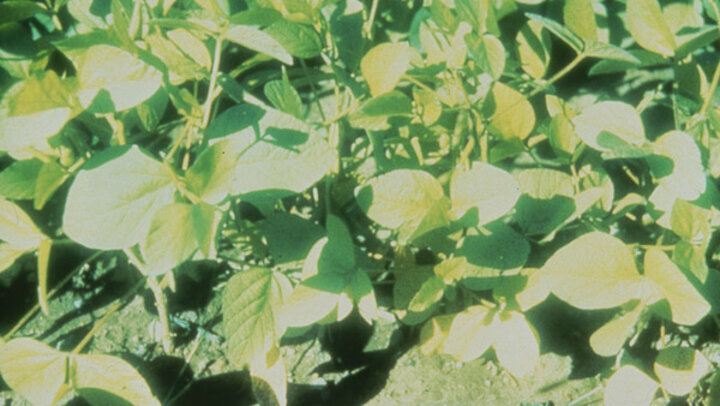
"Leaf margins"
The leaf's edge.
"Interveinal"
Situated or occurring between veins.
"Necrosis"
Localized death of tissue.
Potassium Deficiency Symptoms (Figure 2)
- Slow growth, stunted plants
- Plants are green with chlorosis localized along the leaf margins
- Leads to brown interveinal necrosis while veins stay green
- Symptoms appear first and are more severe on older leaves
- In severe cases younger leaves may show symptoms
- Favored by sandy, weathered, organic soils, heavy K removal by preceding crop, and wet compacted soils
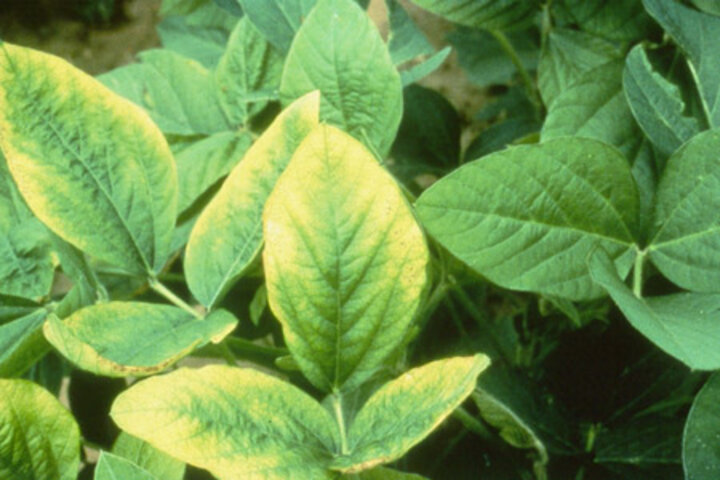
"Weathered"
Worn by long exposure to the air; weather-beaten.
"Blotchy"
Covered with blotches; patchy.
Manganese Deficiency Symptoms (Figure 3)
- Stunted plants, pale yellow leaves with blotchy interveinal chlorosis
- May lead to dark brown necrosis
- Symptoms appear first and are more severe on younger leaves
- Symptoms similar to iron chlorosis
- Problem in high pH sandy soils, soils with a high organic matter content
- Common also in wet and poorly aerated soils, compacted soils and cool weather
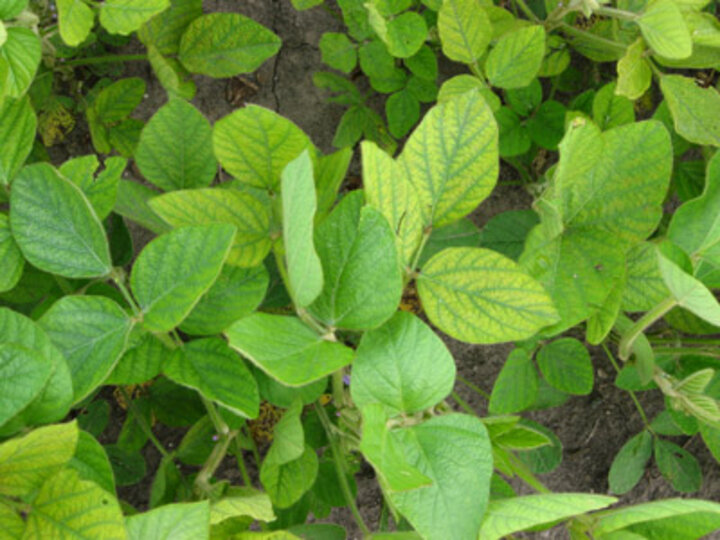
"Lime"
A white caustic alkaline substance consisting of calcium oxide.
Iron (Iron Chlorosis) Deficiency Symptoms (Figure 4)
- Stunting, yellowing of leaf areas between veins, turning almost white, veins may turn yellow
- Symptoms appear first and are more severe on younger leaves
- Similar to manganese
- Iron needed for nodule formation, deficient iron will lead to poor nitrogen fixation
- Common in high pH sandy soils, high lime soils, and cold, wet, poorly aerated soils high in manganese
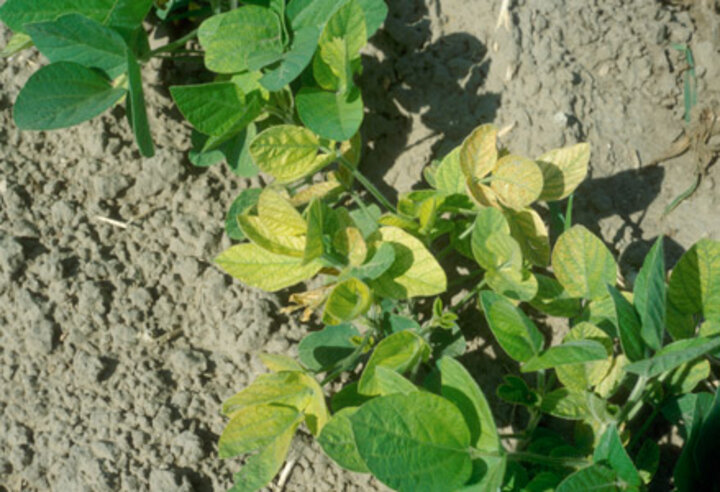
"Aerate"
Introduce air into.
Sulfur Deficiency Symptoms (Figure 5)
- Plants small and slender, entire leaves turn a pale green color
- Similar to nitrogen deficiency except chlorosis appears more severe on younger leaves
- Found in cool wet conditions and on sandy soils with low organic matter content

"Speckled"
Covered or marked with a large number of small spots or patches of color.
Magnesium Deficiency Symptoms (Figure 6)
- Lower leaves will be pale green and yellow blotching will occur between the veins
- Leaves may appear to be speckled bronze in later stages
- Symptoms appear first and are more severe on older leaves and are more localized on leaves
- May occur on very sandy soils, low pH soils

"Mottling"
Discoloration in irregular areas.
Zinc Deficiency Symptoms (Figure 7)
- Pale green plants with interveinal mottling leading to bronze necrosis, veins tend to stay green
- Symptoms appear first and are more severe on older leaves
- Favored when surface soil is removed (erosion, terracing) or conditions with high soil pH and free lime and high phosphorous
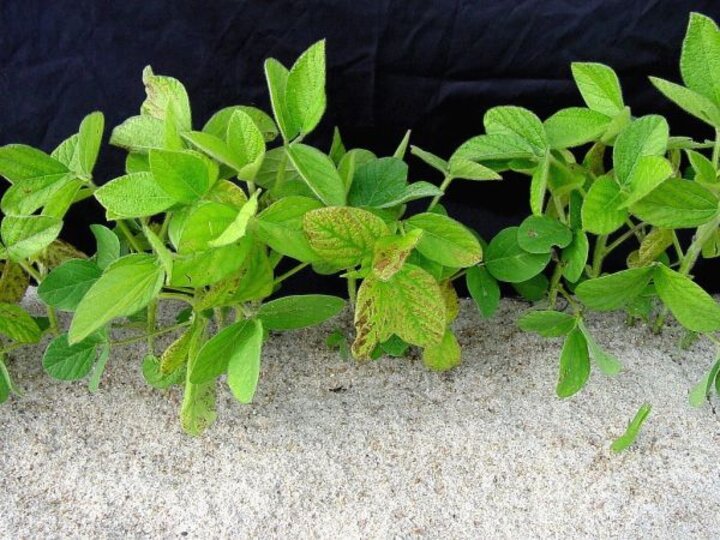
"Spindly"
Thin and weak.
Phosphorus Deficiency Symptoms (Figure 8)
- Slow growth, stunted, spindly plants, delayed maturity
- Dark green to bluish green leaves, may show signs of small lesions
- Leaves may show signs of cupping
- Symptoms appear first and more severe on younger leaves
- Favored in cold soils, either too wet or too dry
- Poor root growth in compacted or low pH soils, root damage by insects or chemicals
- Relative availability of crop nutrients by soil pH
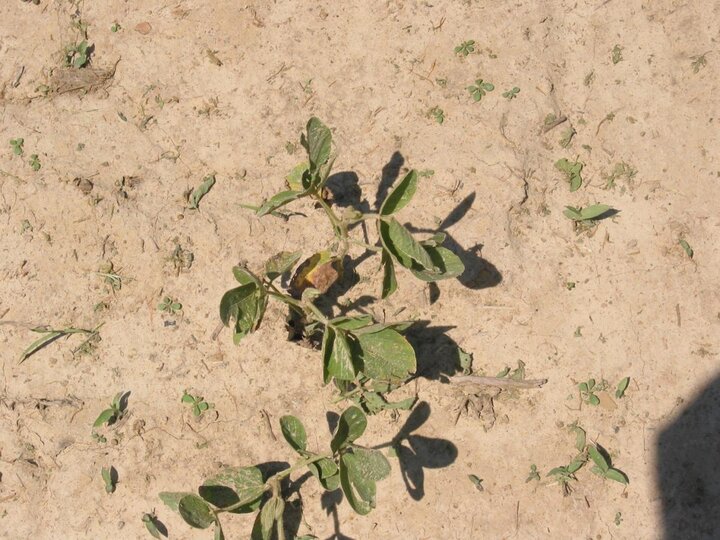
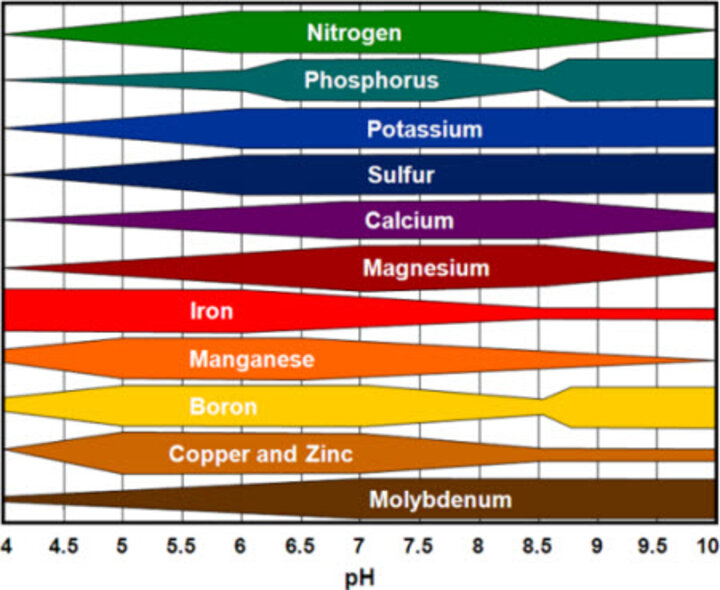
Being able to identify nutrient deficiency symptoms of soybeans will help in making management decision to resolve soil fertility issues and grow healthy, high-yielding soybeans.
The nutrient values given on the soil tests results are the amount of nutrients that are available to the plant can use. By using these values, you can determine fertilizer recommendations. The University of Nebraska provides publications explaining different nutrient requirements and about when, what kind, and how much fertilizer is best to apply.
The more experience you get working with soil test results and management recommendations, the better you will understand the process. Proper soil testing and interpretation of results can help you make smart management decisions that will overall be more economical, better for the environment, and enable you to produce high-yielding soybeans.

Nebraska Soybean Board graciously provided the funding for the Soybean Management Guide.
Course authored by:
Amy Timmerman, extension educator; Aaron Nygren, extension educator; Brandy VanDeWalle, extension educator; Loren Giesler, Plant Pathologist Department head; Ron Seymour, extension educator; Keith Glewen, former extension educator; Charles Shapiro, emeritus extension soil scientist; Amit Jhala, extension weed specialist; Don Treptow, former graduate student
